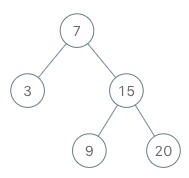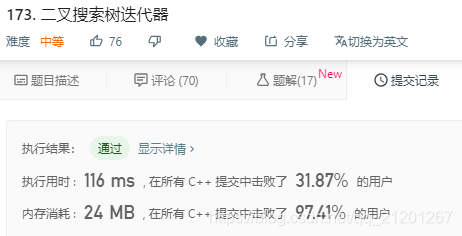文章目录
- 1. 题目信息
- 2. 二叉树中序遍历
1. 题目信息
实现一个二叉搜索树迭代器。你将使用二叉搜索树的根节点初始化迭代器。
调用 next() 将返回二叉搜索树中的下一个最小的数。
示例:

BSTIterator iterator = new BSTIterator(root);
iterator.next(); // 返回 3
iterator.next(); // 返回 7
iterator.hasNext(); // 返回 true
iterator.next(); // 返回 9
iterator.hasNext(); // 返回 true
iterator.next(); // 返回 15
iterator.hasNext(); // 返回 true
iterator.next(); // 返回 20
iterator.hasNext(); // 返回 false
提示:
next() 和 hasNext() 操作的时间复杂度是 O(1),并使用 O(h) 内存,其中 h 是树的高度。
你可以假设 next() 调用总是有效的,也就是说,当调用 next() 时,BST 中至少存在一个下一个最小的数。
来源:力扣(LeetCode)
链接:https://leetcode-cn.com/problems/binary-search-tree-iterator
著作权归领扣网络所有。商业转载请联系官方授权,非商业转载请注明出处。
2. 二叉树中序遍历
- 搜索树中序是非降的

class BSTIterator {stack<TreeNode*> stk;TreeNode *cur;
public:BSTIterator(TreeNode* root) {cur = root;}/** @return the next smallest number */int next() {if(!hasNext())return -1;while(cur){stk.push(cur);cur = cur->left;}cur = stk.top();int v = cur->val;stk.pop();cur = cur->right;return v;}/** @return whether we have a next smallest number */bool hasNext() {return !stk.empty() || cur;}
};/*** Your BSTIterator object will be instantiated and called as such:* BSTIterator* obj = new BSTIterator(root);* int param_1 = obj->next();* bool param_2 = obj->hasNext();*/










)







)
